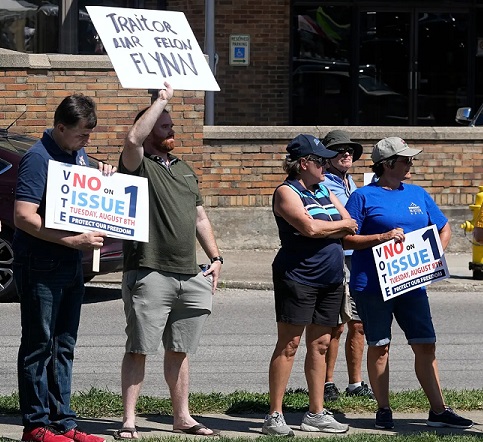Ohio Democrats Say Issue 1 Rejection Could Mean Partisan Shift, But Republicans Stay Confident!
FEATURED PHOTO: OHIO DEMOCRATIC PARTY CHAIR LIZ WALTERS

IdeastreamPublicMedia.org, By Karen Kasler-STATEHOUSE NEWS BUREAU, Posted August 14th 2023
The resounding defeat of the Republican-backed Issue 1 – in a state that Donald Trump took twice and Mike DeWine won by almost 2-1 last year – has raised questions about whether there’s a political shift starting toward Democrats, or if Republicans continue to have a firm hold over Ohio.
The morning after Issue 1 lost, Ohio Democratic Party chair Liz Walters admitted to reporters she doesn’t say thanks to Republicans very often, but she was feeling gratitude toward one particular member of the Ohio GOP.
“I want to thank Frank LaRose, who was the chief campaigner for Issue 1, who not only lost but made a lot of mistakes in the process, including admitting the quiet part out loud: that Issue 1 was 100% about abortion,” Walters said. “After last night. I think it’s safe to say that Frank LaRose can officially be crowned Ohio’s biggest loser.”
Issue 1 would have made it harder to pass future constitutional amendments, including one in November guaranteeing abortion rights.
LaRose is one of three Republicans hoping to run next year against Democratic incumbent U.S. Sen. Sherrod Brown, who is expected to face an uphill battle. But Democrats have long claimed gerrymandering has created an extremist legislature, and some are saying Issue 1’s defeat shows Ohio isn’t as red as electoral maps make it look.
Mark Weaver is a longtime Republican strategist and is strongly anti-abortion. He noted gerrymandering doesn’t cover statewide candidates nearly all of whom are Republican. And he predicts the best known Democrat in Ohio, Brown, will lose.
“We are now in a red state. When I first moved to Ohio, it was a purple state. It’s now a red state,” Weaver said. “The thing with Issue 1, I think, is more of an outlier and less of a partisan trend.”
Weaver chalked up the defeat of Issue 1 to voter confusion at what it would do and voter frustration at an unexpected August vote, but he also said voters’ views on abortion certainly were a factor. Cedarville University political science professor Mark Caleb Smith agreed, and said the Issue 1 results don’t necessarily suggest Democrats will see a surge in support.

“I think we should be very careful before we read too many results into this particular outcome. This is a special election on a very narrow issue,” Smith said. “I think the November ballot initiative, when abortion is on the ballot and there’s a concrete policy in place, will probably give us a little bit better indication of what the state thinks about abortion. But again, I’m not sure that’s going to mean what the state thinks about the Democratic Party, because it’s just a more complicated issue than that.”
But Melissa Miller, a political science professor at Bowling Green State University, sees it differently.
“I think Ohio’s party politics are apparently more in flux than a lot of observers believed. And in fact, it really kind of hearkens back to the years when Ohio, for decades, really was a battleground state. And we could swing either way,” Miller said. “Issue 1 is not a perfect proxy for party politics in Ohio, but it’s a rough proxy. The fact that the side favored by the Democrats, favored by those who are pro-choice, won with a 14-point margin, suggests that maybe Ohio isn’t as red.”
Abortion is a complicated and critical issue for both parties
The Issue 1 results in Ohio, coupled with abortion rights being upheld in red states including Kansas and Kentucky, have shaken anti-abortion activists, according to Mark Weaver.
“The pro-life community is kind of split,” Weaver said. “Some people think, get everything you can, get the most restrictions, save as many babies as possible. Others say, let’s work within what’s real and what will be upheld by the courts. So I think it’s a fair question to say: whither the pro-life movement and what’s next? And I know a lot of good people will be putting their thoughts and their hearts into that decision.”

And that brings up the question of whether abortion is still a strong issue for Republicans or whether the overturning of the federal right to abortion and sending it to states to regulate it has flipped the issue toward Democrats.
The Ohio Democratic Party’s Liz Walters said while she’s pleased with the Issue 1 results, she doesn’t make assumptions about where Ohio is headed.
“I can safely assure you I am not overconfident about anything. We are very, very, very realistic about the work yet to do in this state.”
Republicans said they’re moving on toward November, but leaders of the pro Issue 1 campaign are considering why it lost. Some have said there wasn’t unity among Republicans, with some former officeholders joining the anti-Issue 1 side. And Senate President Matt Huffman has said there wasn’t time to build a victory between when he and other lawmakers voted to put it on the ballot in May and the vote in August.








